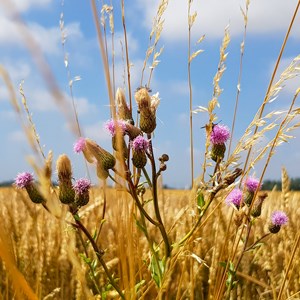Contact
eirini.daouti@slu.se, 018-67 20 49

Field management intensity weakens the ecosystem service of weed seed predation. This is shown by SLU researchers in a new study. In addition, a new metric was developed that can assess the strength of weed seed predation.
Many small rodents and carabid beetles like to eat weed seeds and we benefit from that in agriculture. But what are the effects of agricultural management intensity on weed seed predation? To what extent does the availability of undisturbed habitats provide refugia for weed seed predators to the disturbances related to agricultural management? And how does this affect the ecosystem service of weed seed predation?
These were questions that researchers Eirini Daouti, Benjamin Feit and Mattias Jonsson wanted to know the answers to.
– Using data from 13 fields in Southern Sweden, we measured weed seed predation in the fields using seed cards and estimated the strength of predation for each predator, says Eirini.
The researchers combined data on seed predator abundance with what they prefer to eat to develop a metric that approximates the strength of weed seed predation.
– We then explored how field management intensity and habitat refugia affected weed seed predation rates, and assessed the importance of seed availability, says Eirini.
Increasing field management intensity reduced weed seed predation, but this was dependent on reduced seed availability.
– Weed seed availability seems to be an indirect mechanism by which field management limits seed predator potential for weed seed predation. We found no evidence that either crop or non-crop refugia can increase seed predation during disturbances in the crop, says Mattias Jonson.
Weed seed predation can therefore be promoted by reducing disturbances at the field level, regardless of the availability of disturbance refugia in the landscape.
– In the future, we need to explore if supporting a diversity of non-competitive weeds to enhance seed availability can improve the suppression of dominant and competitive weed species, concludes Eirini.
eirini.daouti@slu.se, 018-67 20 49
Read the scientific article “Agricultural management intensity determines the strength of weed seed predation” in Agriculture, Ecosystems & Environment.